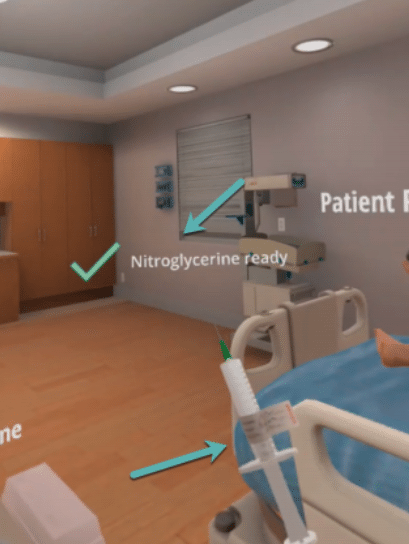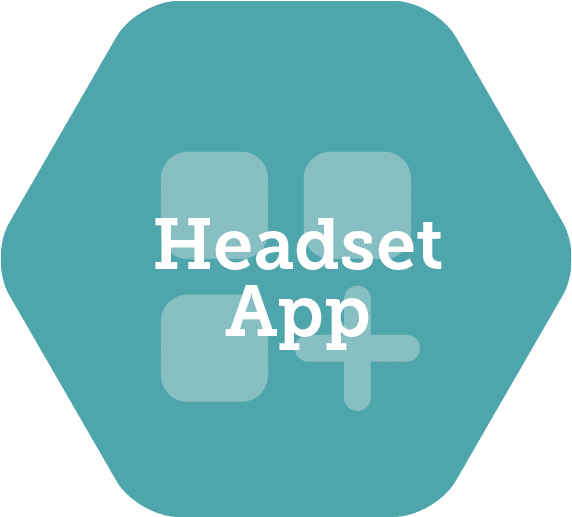Designing a VR training scenario, or a 3D learning experience, requires careful consideration.
It can be easy to get caught in the trap of relying on familiar 2D design patterns, such as text panels, videos and pictures to convey information and instructions. For a 3D scenario to truly have a transformative impact, you need to move away from simply delivering slides and e-learning in a VR headset. The learner needs to be the actor in the scenario, not the observer. Adding the following questions and considerations as part of your storyboard or planning documents will help put you in a 3D mindset:
- What does the learner see at this step?
- What does the learner hear?
- What kind of choices does the learner need to make? What should they consider?
- What action does the learner take?
- What is the result of that action (including a description of visual cues, sounds etc.)?
- How should the learner proceed based on the feedback?
- What does the learner interact with?
Depending on the type of scenario, whether it be branching, step by step, or open world, we use different tools for planning. Some of our favourites are Milanote, Twine and Lucidchart. But we always come back to the questions above as our guiding principles for the design. The spreadsheet linked here is a very basic planning document that we include in Motive’s process to ensure that we keep the 3D medium at the centre of our planning.
3D Environment
Creating a convincing replica of a work environment that runs well in a VR headset with soothing lighting and smooth animations is not an easy task for a VR novice. Excellent 3D artistry takes years of practice. If you are new to designing for VR, you must consider where your 3D assets will come from and how they will be set up. It is worth it to partner with a knowledgeable 3D artist who has experience optimizing assets for VR.
Using the Space
One of the most powerful things about learning in 3D is the ability to connect movement (with 6 degrees of freedom) and the layout of the space to the training task. You have a replica of the workspace, so make sure you use it!
A few tips for using the space well:
- Place tools, equipment, and job aids in the 3D environment where they would actually be in the real environment.
- If you are able to replicate activities through object interaction, do it! For example, don’t use a multiple choice question that says “What would you do now?” and give options to choose. Instead, prompt the user to make the decision by actually doing what they would do next. You can then build in real and natural consequences if they take the wrong action.
A few things to consider:
- You have no control over where the learner will be looking at any given time. Feedback and instructions should be given in multiple ways using sounds and visual cues. If the information you are conveying is essential, you may want to consider making it available to the learner after the fact (in case they miss it).
- It is really annoying to have something stuck to your face! A common design mistake that new 3D experience designers make is to add static UI elements, like a menu icon, visible in the learner’s field of view. This seems like a good idea, but in reality, it feels like you have a fly on your glasses. Instead, you can make information available through the click of an object in the scene.
- Some object interactions do not need to be replicated. While it is important for the learner to be active instead of passive, there are some actions that are unnecessary and can make the experience frustrating. You can easily end up with a scenario where trainees are learning how to use VR controllers and not focusing on the actual subject matter. To determine high value interactions, keep the learning goals for your training in mind.
Providing Feedback
VR learning scenarios are so immersive it is important to provide very clear feedback on progress to keep the learner on track. Feedback can, and should, come in many forms in a VR learning scenario. You have access to more of the learner’s senses when implementing the training, so when the learner completes a step, feedback should be at the very least visual and auditory.
Visual feedback could include:
- A text notification – including icons to indicate “correct” or “incorrect”
- Highlighted objects
- Visual change of state for an object in the scene – for instance, something going from “dirty” to “clean” in a cleaning task
Auditory feedback could include:
- Voiceover – a guide telling you “good job” or “try again”
- Buzzes, dings and beeps to accompany text notifications
- Change in sound of an actual object – for instance, turning down the volume leads to quieter music
You could also include haptic feedback from the controllers to emphasize an action.

There are many considerations when creating your VR training scenarios. You need to put yourself into the shoes of the trainee while thinking about the 3D environment, usage of the space, and the methods of providing feedback. Keeping these points in mind while designing your scenes will help you create an effective immersive training experience for your employees.
Are you considering VR training but would like to see more proof of its benefits?
Download our white paper: The Case for Immersive Training.
Latest Posts
Stay in the Know
Want to stay up-to-date with what is going on in the world of immersive training? Subscribe to the Motive Blog.
Ready to revolutionize your training program?
We’re ready to show you how seamlessly you can create, edit and deploy VR training modules. Our team is standing by to help you revolutionize your training program.





